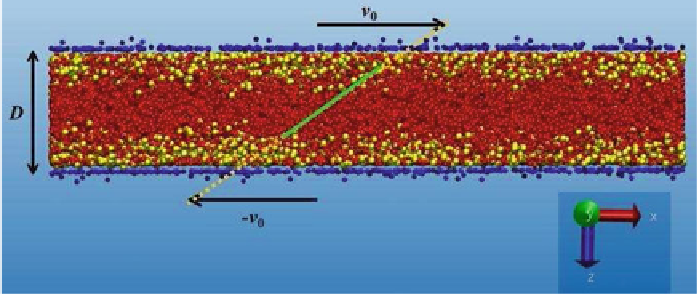Environmental Engineering Reference
In-Depth Information
Fig. 11
A system configuration extracted directly from non-equilibrium computer simulations
using soft DPD interactions of polymer brushes grafted on soft DPD surfaces. The
blue
particles
are the grafted beads which move at constant speed
v
0
in the direction indicated by the
arrows
.
Those beads drag the rest of the beads forming the polymer chains (in
yellow
) to produce flow of the
solvent particles (in
red
). The
green line
indicates the velocity gradient as is expected in stationary
Couette flow. Adapted from Gama Goicochea et al. (
2014
)
enhanced oil recovery, for the design of improved rheology modifiers in the paint
industry, as well as lubricants, to mention a few. The idea behind non equilibrium,
stationary flow simulations for applications like those mentioned above is as follows:
two parallel plates are placed a certain distance apart, say in the
z
-direction; then
a constant force is applied to the top plate and an equal in magnitude but opposite
in direction force is applied to the bottom plate. This creates a velocity gradient (or
shear rate) which is responsible for creating a steady flow known as Couette flow. We
shall have more to say about the details of this type of flow in the next section, but
for now we focus on the use of soft DPD potentials in non-equilibrium simulations.
Although many works have been published that use computer simulations to study
Couette flow, most of them have been carried out using microscopic models, which
are accurate but are very time-consuming, even more than equilibrium simulations.
Recently, a study of the rheological properties of polymer brushes under theta solvent
conditions using only soft DPD interactions has been published (Gama Goicochea
et al.
2014
). The system consists of two parallel plates on the
xy
-plane, modeled as
soft DPD wall forces separated by a fixed distance
D
, where a number of polymer
chains were grafted at one of their ends and at grafting densities large enough to
form polymer brushes. A constant velocity
v
0
is applied to the grafted ends of the
polymer chains on the top and bottom plates, in opposite directions, so that stationary
flow is produced by the collisions of the chains with themselves and with the solvent
particles. This gives rise to a mean constant force
F
x
in each plate, in the stationary
regime. The grafted beads on the surfaces move with a constant velocity (
v
0
)but
there is a velocity gradient of constant shear rate
along the direction separating the
plates. Figure
11
shows a configuration of this system, extracted directly from the
simulations.
ʳ

Search WWH ::

Custom Search